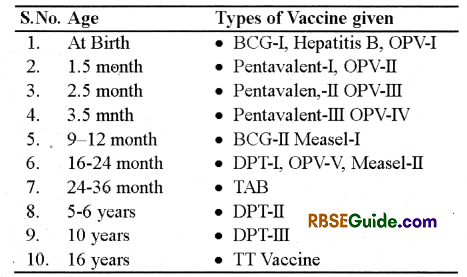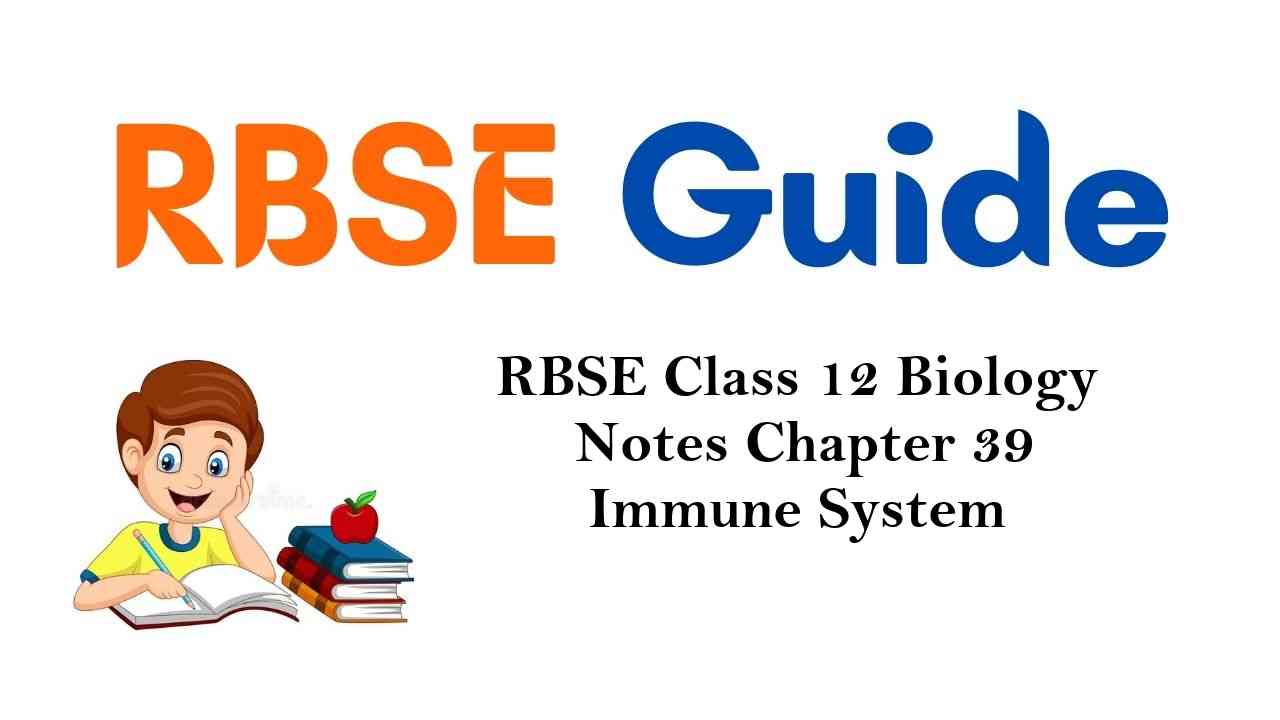Rajasthan Board RBSE Class 12 Biology Notes Chapter 39 Immune System
General
Our body get infected by bacteria, viruses, fungi and parasitic organisms. For protection,lour body is equipped with a very specialized defense mechanisms which is called as Immune system. This system protect us from infection caused by this causative organism.
![]()
Immuniy and Immunology
- “The resistance acquired by the body to fight against diseases or microorganisms or toxic product” is called Immunity.
- Term Immunity originated from Latin word Immunis which means free of burden [Capability to protect from infectionous factor],
- The branch of science which deals with the study of immunity is called Immunology. It deals with the study of various component of Immune system and their functions. It provides immunity against organisms.
- Our body has the capacity to distinguish between body cells (‘self’) and foreign materials (‘non-self’). It will react to the foregin materials with an immune response that eliminates the intruding material from the body.
Types of Immunity
In broad terms, immunity is of two types viz :
- Natural or Innate Immunity
- Acquired Immunity
Natural or Innate Immunity
This Immunity is inborn i.e.it exists since birth.
It is independent of previous experience.
There are four types of innate protective meausres a gaginst invading germs :
- Anatomical barriers
- Physiological barriers
- Phagocytic or celular balriers
- Inflammatory barriers.
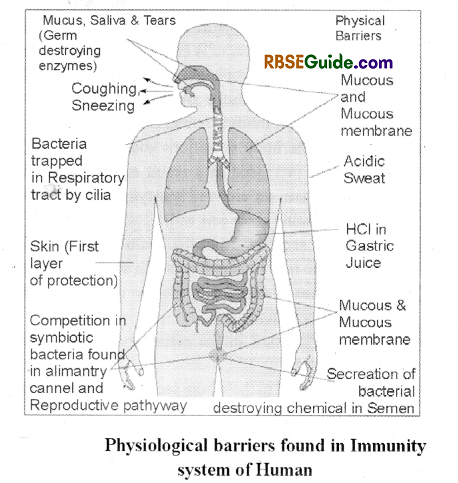
Physical Barrier
It prevents entry of disease causing agents into the body. This is the first line of defense in the body. The following organs are involved in it :
(A) Skin
- It is the first line of defense.
- It’s outer layers of epidermis are dead due to deposition of Keratin protein and it forms a barrier layer. The germs can’ll penetrate this layer.
- The dermis has many sebaceous gladns which secrete an oily secretion called Sebum. Sebum has lactic acid and fatty acid which maintain the pH of skin in between 3 to 5. Most of the microorganisms do not survive in this pH.
- Most of the bacteria also do not grow in this pH.
![]()
(B) Mucous Membrane :
Many bdy organs such as. Respiratory system, digestive system and reproductive system having a layer of epithelium cells which are covered with a protective layer of mucus. If the germ falls on this path, then they get destroyed in the protective mucus layer. It thus, restricts the entry of such agents which may otherwise prove to be infectious.
The mucus membrane also having enzyme called lysozyme which acts as germicidal.
Physiological Barriers
Many physiological activities in the body prevent entry of the germs into the body. Some of them are as follows :
(i) Fever : The invading germs secrete different types of toxins. As a result number of WBC is increased to destropy them. In addition, macrophages are also increased which secrete pyrogens. These pyrogens increase body temperature which inhibits bacterial growth.
(ii) Lysozyme : The body secretions such as tears, saliva, sweat etc. are increased as a result of infection. These secretions contain an enzyme lysozyme which kills the germs by digesting their cell wall.
(iii) The stomach secretes dilute HC1 which makes the pH strongly acidic (pH 1 to 2). It acts as a strong germicidal.
(iv) There is release of bile juice into the duodenum which aslo acts as germicidal.
(v) The mucous secreted in the respiratry passage acts as barrier for germs.
(vi) The cerumin found in the sebum secreted by the sebaceous glands of the skin also kills germs.
Cellular Phagocytic Barrier
It is an important technique of innate Immunity. It involves some special cells wfhich destroy the germs by phagocytosis. It was discovered by E. Metchnikoff. These phagocytic cells are as follows :
(A) Leucocytes or WBC
- Any infection in the body results in Leucocytosis (Increased number of WBC). The neutrophil WBC destroy the germs by phagocytosis The neutrophils have phagocytin and lactferin which are antibacterial
- The monocyte WBC also destroy the germs by phagocytosis.
- The Lymphocyte WBC are of two types : B & T lymphocytes. Thy destroy the germs by forming antibodies
(B) Macrtophages :
They are modified monocytes which perform phagocytosis. The macrophages found in the blood stimulate formation of antigen antibody complex.
They have large amount of lysozyme enzyme.
Inflammatory barrier/Cytokine Barrier
- Inflammation is an important defense mechanism of host to prevent infection. It is induced in response to tissue damage caused by microorganism, toxins or by mechanical means. Main aim of inflammation is to prevent spreading of injected microorganism or toxin from site of infection and kill them on spot by phagocytosis.
- In this mechanism mast cell of connective tissue and basophils of WBC secrets a chemical indicator in the form of Histamine and Prostaglandin. Through its secretion maks the blood cell more permeable. Plasma and phagocytes come out from the cell and function accordingly. Serum also has a potential to destroy bacteria.
Acquired Immunity
- This immunity does not exist since birth but it is gained after birth based on the memory of the body. Hence, it is called as acquired immunity.
- This Immunity is obtained either from the development of antibodies in response to exposure to an antigen, as from vaccination or an attack of an infectious disease, or from the transmission of antibodies, as from mother to foetus through the placenta or the injection of antiserum.
- It provides third line defence to the body.
![]()
It highly specific for an antigen. When an antigen, first time enters into body, our immunity system makes specific antibody against it which is called Primary Response. In this response memory cells are formed. When the immune system encounters a specific foregin agent, (e.g., a microbe) for the first time, it generates immune response and eliminates the invader. This is called first encounter. The immune system retains the memory of the first encounter. As a result, a second encounter occurs more quickly and abundantly than the first encounter. It is called as Secondary Response.
It is of two types :
- Active and
- Passive
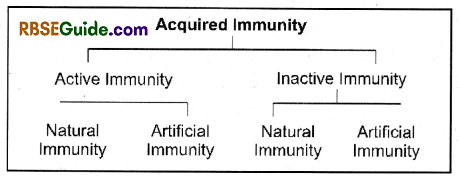
Active Immunity
immunity
- It is a slow process but it acts for long duration.
- Natural active immunity is acquired by exposure of organism to pathogens.
- Artificial, active immunity is acquired through vaccination of inactivated pathogen or antigen.
Passive Immunity
The immunity that an individual acquired by receiving antibodies or senstitized white blood cells from another immune individual is known as Passive immunity. The protection however, is temporary and usually less effective. IgG antibodies can cross placental barrier to reach the foetus. Ig A antibodies are transferred from mother to child in the form of colostrum.
Auto Immunity
Auto immunity is present to some extent in everyone and is usually harmless. However, auto immunity can cause a broad range of human illnesses, known collectively as Autoimmune disease. Autoimmune disease occurs when there is progression from beign autoimmunity to pathogenic autoimmunity. This progression is determined by genetic influences as well as environmental triggers.
Example : Rheumatoid Arthritis
Vaccination
General
- Vaccination is a biotechnique.
- First vaccine was prepared by Edward Jenner, 1798. He prepared a vaccine for small pox.
- Cow is called as Vaca in Latin. Cow was used in the
- preparation of the first vaccine. Hence, the term “Vaccine” was coined. ,
- In this technique, the cause (germs) of specific disease are injected in dead state/living but weakened state to
- produce anitobides in the body against the specific disease.
- The vaccine provides Active acquired immunity to a particular disease.
- Jenner took fluid from a cowpox blister and scratched it into the skin of James Fipps, an eight-year-old boy.
- Ienner is known as the Father of vaccination for this contribution.
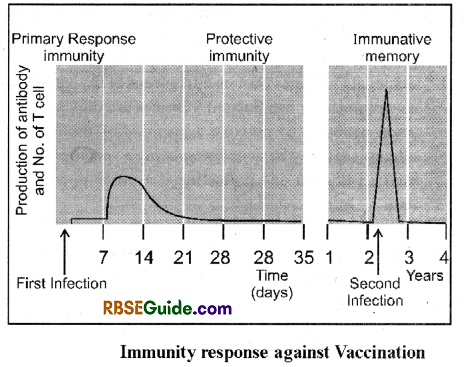
![]()
Types of Vaccine
The vaccines are of following types :
Live or Attenuated Vaccines
Attenuated vaccines can be made in several different ways. Some of the most common methods involve is passing the pathogen virus through a series of cell cultures or animal embryos (typically chick embryos). The virus is grown in different embryos in a series. With each passage, the virus loses its ability to replicate in human cells.
Example : Measles, Mumps, Rubella, Influenze (nasal spray), Rotavirus, Oral polio. (OPV).
Killer or Inactivated Vaccines
One alternative to attenuated vaccines is a killed or inactivated vaccine. Vaccines of this type are created by inactivating a pathogen, typically using heat or chemical such as formaldehyde or formalin, Phosphin etc. This destroys the pathogen’s ability to replicate, but keeps it “intact” so that the immune system can still recognize it.
Example-Polio injection (IPV), Hepatitis A, Rabies Typhoid Diorrhoea Rabbies.
Toxoid Vaccine
- Some diseases are not directly caused by a bacterium itself, but by a toxin produced by the bacterium. Such as Tetanus. Its symptoms are not caused by thtClostridium tetani bacterium, but by a neurotoxin it produces
(tetanospasmin). - Immunizations for this type of pathogen can be made by inactivating the toxin that causes disease symptoms.
- Example-Tetanus Diptheria.
- Immunizations created using inactivated toxins are called toxoids.
Conjugate Vaccines or Subunit Vaccine
Conjugate vaccines contain only pieces of the pathogens they protect against. Sub unit vaccines use only part of a target pathogen to provoke a response of the immune system. This may be done by isolating a specific protein from a pathogen and presenting it as an antigen on its own.
Example : Pertusis vaccine and Influenze vaccine
Engineered Vaccine or Recombinant Vaccine
- These Vaccines are made at large scale by genetic engineering technique. They are made with the help of Yeast and Bacteria. Example-Hepatitis.
- A gene coding for a vaccine protein is inserted into another virus, or into producer cells in culture. When the carrier virus reproduces, or when the producer cell metabolizes, the vaccine protein is also created.
- The end result of this approach is a recombinant vaccine : the immune system will recognize the expressed protein and provide future protection against the target virus.
- Example-Hepatitis B, Influenze (injection), Haemophilus influenze type b (Hib), Pertussis (part of DTaP combined immunization), Pneumococcal, Meningococcal.
Vaccination Programme in India
Under NIP (National Immunization Programme), a new vaccination programmed was started in India from November 2014 which is as follows :
